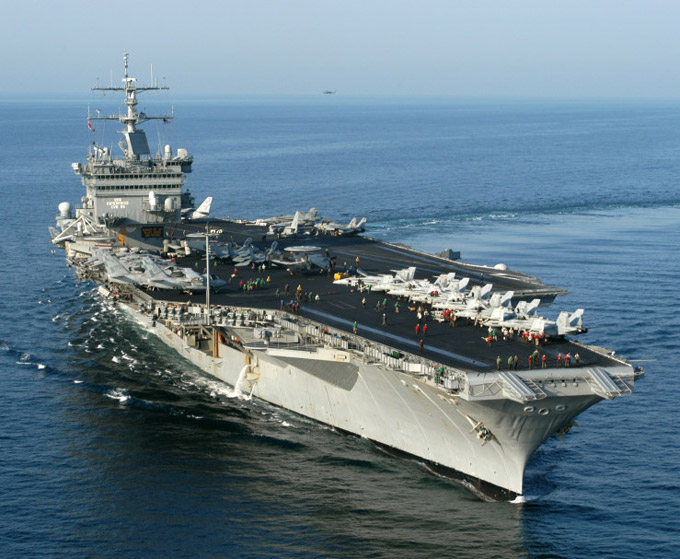
Why Does A Ship Float in Water and I Sink?
Phil Kesten
When I jump into a swimming pool, I sink like a stone unless I flail about wildly, but when the USS Enterprise aircraft carrier – which is just a tad bigger and tad heavier than I am – jumps into the ocean, it floats with no effort whatsoever. What’s going on? Let’s wonder a bit about the science of floating.
Some big, heavy things – like the USS Enterprise – float in water. Some small, light things, like a ball bearing, don’t. So size doesn’t determine whether something floats, and neither does weight. Let’s start by identifying what causes something to float or not.
Everything on Earth, whether on the surface or under water, has the weight of everything higher up pushing down on it.
Everything on Earth, whether on the surface or under water, has the weight of everything higher up pushing down on it. Yes, right now as you read this, the weight of all of the air above you, right up to the top of the atmosphere, is pushing down and in on you. The resulting force is about 14.7 pounds on every square inch of your body. 14.7 pounds per square inch, or psi, is the normal, average atmospheric pressure on the Earth.
If you dive down into water, you’ll not only have the weight of the air up above pushing in on you, but the weight of all of the water above you as well. Water is relatively heavy – go down just 30 feet and the weight of the water per square inch on your body will equal the weight of the hundreds of miles of air above you.
Why doesn’t the weight of all that air and water push you down, down, down, after you dive into a swimming pool? The answer is simply that the water below you is pushing up.
Water wants to be where you are
There you are, underneath the surface in a swimming pool. Water wants to be where you are – your body has displaced a whole lot of it. If you suddenly disappeared, water would rush in to fill the space. It is the force of that potential “rushing in” that results in a force acting against the weight of the air and water above you. This is the buoyant force.
The buoyant force depends on how much water an object displaces. The larger the object, the greater the buoyant force it experiences. Ah, but will that object float?
An object floats when the buoyant force is large enough to counter the object’s weight. So a large hollow object might float because large means more water displaced – so more buoyant force – and hollow means relatively little weight. A small solid object might not float, however. Less water displaced results in a smaller buoyant force. If that buoyant force isn’t enough to counter the weight of the object, it will sink.
So yes, the USS Enterprise weighs far more than I do. But the weight of the water it displaces is more than the weight of the aircraft carrier, so it floats. Me, I weigh more than the water I displace, so I sink.
You can get a feel for how much water the USS Enterprise displaces from this photo:

the USS Enterprise
The keel of the boat is deep under the water, and the ship is quite wide for most of its length. So that’s a lot of boat volume under the surface, all of which is displacing water.
------------------------------------------------------------
Questions to ponder:
If you roll a blob of clay or putty into a ball and drop it into a pot filled with water, it sinks. But it floats after you flatten it and curl it up into a cup shape. (Try it!) What’s going on?
A person can float effortlessly in the Great Salt Lake or the Dead Sea. Why is that possible?
May 6, 2016

